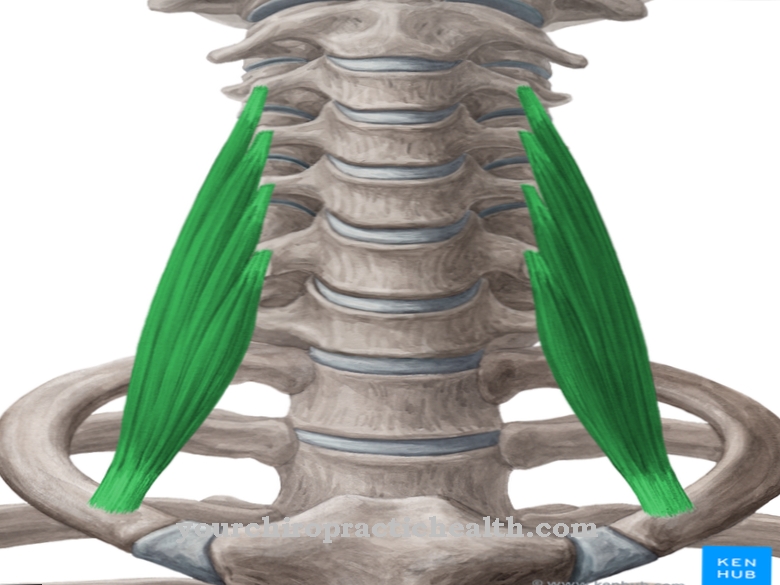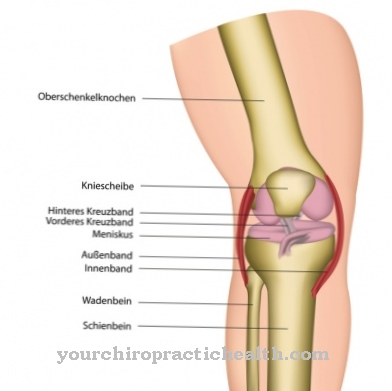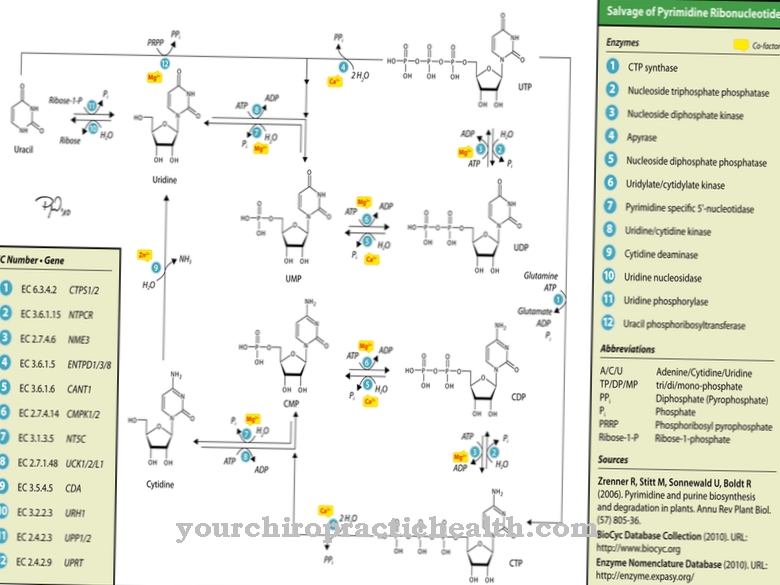Of the Suprascapular nerve innervates special muscles of the shoulder area. The functions of the nerve are explained by the location and type of signal transmission. Mechanical and biochemical nerve damage can lead to diseases and complaints that are explained in more detail below.
What is the suprascapular nerve?
The suprascapular nerve is a sensorimotor nerve. Colloquially, one speaks of a mixed nerve. Motor nerve fibers of the suprascapular nerve innervate muscles, while sensory fibers lead to the shoulder joint.
The fibers that exclusively supply the skeletal muscles are called somatomotor fibers. The fibers that convey impulses from mucous membranes, skin, muscle spindles and receptors in tendons and joint capsules are known as general somatosensitive fibers. The suprascapular nerve is a peripheral nerve and, like most peripheral nerves, not only has one of the aforementioned conduction qualities. Due to the type of innervation, the nerve has both somatomotor and general somatosensitive fibers or parts. The fibers of the nerve are part of a nerve plexus that in turn projects to the spinal nerves.
Anatomy & structure
The suprascapular nerve is part of the brachial plexus and has its roots in the superior trunk in the 5th and 6th neck segments (C5-C6). The superior trunk is one of the three main trunks that form from the spinal nerves. The suprascapular nerve branches off from the superior trunk and runs to the scapular notch. The nerve passes through the incision and runs to the supraspinous fossa.
Then the nerve runs along the supraspinous fossa and along the scapular collum into the infraspinous fossa. There the nerve forms motor and sensitive branches. The motor fibers innervate the supraspinatus and infraspinatus muscles, while a sensitive nerve branch extends to the shoulder joint. The suprascapular nerve is a peripheral nerve. Like most peripheral nerves, the suprascapular nerve consists of several axons that are surrounded by myelin sheaths, the so-called Schwann cells. Schwann cells are peripheral glial cells that form the myelination of neuronal processes. Schwann cells can only be found in the peripheral nervous system and are used for the saltatory conduction of excitation.
Function & tasks
The somatomotor nerve fibers innervate the supraspinatus and infraspinatus muscles. As somatomotor nerve fibers, they carry the excitation from the CNS on to the muscles. The innervated muscles react to the excitement and perform their intended tasks. The supraspinatus muscle spreads the arm up to an angle of 15 °. The muscle acts as an agonist.
The spreading of the arm is also referred to medically as abduction. The further rotation and abduction movements are then performed by two other muscles, the deltoid muscle and the infraspinatus muscle. No muscle can work without the innervation of a nerve. Therefore, the suprascapular nerve is responsible for the work of another muscle, the infraspinatus muscle. This muscle is located in the dorsal area of the shoulder muscles and, together with the above. Muscles responsible for the rotation of the arm. During the rotational movement, the muscle primarily ensures the external rotation of the upper arm. The suprascapular nerve innervates the shoulder joint and conveys sensory information.
The information can include pressure and pain information, for example, and is passed on to the CNS via the spinal cord. Sensory information is conveyed depending on receptors. If a receptor reacts, this reaction leads to information being passed on to the corresponding nerve cells. The trigger for a reaction of a receptor is of different nature. For example, pressure receptors only react from a certain pressure. In summary, the suprascapular nerve fulfills the following tasks:
- Transmission of excitation to innervated muscles
- Abduction of the arm up to 15 °
- External rotation of the upper arm
- Sensory information transfer from the shoulder joint to the CNS
You can find your medication here
➔ Medicines for joint painDiseases
Discomfort in the shoulder area is common and may come from the suprascapular nerve. For example, carrying heavy objects on your shoulder can lead to suprascapular nerve compression syndrome.
In compression syndrome, paralysis of the nerve occurs. Because the nerve is paralyzed, the innervated muscles can no longer be moved. This leads to a failure of the rotator cuff and can lead to a dislocation of the shoulder joint. Paralysis of the suprascapular nerve does not only occur in the compression syndrome, but can also be caused by the incisura-scapular syndrome. Although this syndrome also describes the compression of the nerve, the cause of the compression is different. The ossification of a ligament (ligamentum transversum scapulae superius) creates a bony canal.
The nerve pulls through this canal and is compressed. Rotation of the shoulder may maximize compression. The result is paralysis of the suprascapular nerve. Of course, traction (compression or stretching) of the nerve can also occur as a result of physical activity as a result of excessive or incorrect loading. A rupture of the rotator cuff would be conceivable due to incorrect physical exertion. The traction also leads to discomfort.
Starting with complaints in the course of movement to dislocation of the shoulder. If shoulder pain and problems occur with the movement of the shoulder, the orthopedic surgeon should be consulted. This can either confirm or rule out traction of the suprascapular nerve. Going to the doctor in good time prevents permanent neuropathy as a result of an incorrect load or an athletic injury. The orthopedic surgeon can also treat the consequences of age-related ossification of a ligament.














.jpg)













